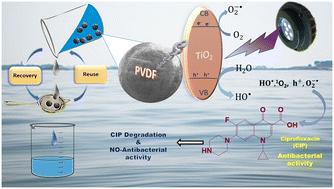当前位置:
X-MOL 学术
›
Environ. Sci.: Nano
›
论文详情
Our official English website, www.x-mol.net, welcomes your
feedback! (Note: you will need to create a separate account there.)
Nano-TiO2 immobilized polyvinylidene fluoride based spongy-spheres for ciprofloxacin photocatalytic degradation: antibacterial activity removal, mechanisms, UVA LED irradiation and easy recovery
Environmental Science: Nano ( IF 5.8 ) Pub Date : 2024-06-25 , DOI: 10.1039/d4en00302k Laxman G. Raikar 1 , Atul Patel 1 , Jemi Gandhi 1 , K. V. K. Gupta 2 , Halan Prakash 1
Environmental Science: Nano ( IF 5.8 ) Pub Date : 2024-06-25 , DOI: 10.1039/d4en00302k Laxman G. Raikar 1 , Atul Patel 1 , Jemi Gandhi 1 , K. V. K. Gupta 2 , Halan Prakash 1
Affiliation

|
TiO2 is promising for the photocatalytic treatment of water contaminated with organic micropollutants. However, it is hard to recover TiO2 slurry from water. Energy-intensive separation methods are required to recover TiO2, which is a setback in the effective use of TiO2 in water treatment. Herein, we present nano-TiO2 immobilized with polyvinylidene fluoride spongy beads (TP) via simple phase inversion of the mixture of TiO2 (1%), PVDF (13%) and PVP (0.7%) for the degradation of ciprofloxacin (CIP), a micropollutant in water, under UVA LED irradiation with easy TP recovery. The stable immobilization of TiO2 with PVDF beads is attributed to interactions between Ti and F atoms. The pseudo first-order rate constant value (kobs = 0.0761 min−1) was determined for the degradation of CIP by TP. Radical scavenging, chronoamperometry, and ESR analysis revealed the presence of O2−˙, h+, HO˙ and 1O2 reactive species. LC-HRMS analysis detected ten degradation byproducts with possible degradation pathways. Importantly, the antibacterial activity of CIP against Bacillus subtilis and Escherichia coli was totally removed after 60 min treatment. TP beads were easily recovered using a simple strainer. TP was recovered and reused 30 times, and the absence of significant TiO2 leaching into water demonstrated its stable immobilization. TP photocatalysis under UVA LED irradiation proves an energy-efficient treatment method with an electrical energy per order of 24.20 kW h m−3. Overall, the study highlights a concrete way to effectively use the TiO2 photocatalyst for water treatment via immobilization using a simple phase inversion method.
中文翻译:

纳米 TiO2 固定化聚偏二氟乙烯海绵球用于环丙沙星光催化降解:抗菌活性去除、机理、UVA LED 照射和易于回收
TiO 2 在光催化处理有机微污染物污染的水方面具有广阔的前景。然而,从水中回收TiO 2 浆料是很困难的。需要采用能源密集型分离方法来回收 TiO 2 ,这阻碍了 TiO 2 在水处理中的有效利用。在此,我们通过 TiO 2 (1%)、PVDF (13%) 和PVP (0.7%) 在 UVA LED 照射下可降解水中的微污染物环丙沙星 (CIP),并且易于 TP 回收。 PVDF 珠对 TiO 2 的稳定固定归因于 Ti 和 F 原子之间的相互作用。确定了 TP 降解 CIP 的伪一级速率常数值 (k obs = 0.0761 min −1 )。自由基清除、计时安培法和 ESR 分析显示存在 O 2 − ˙、h + 、H2O˙ 和 1 O < b13> 活性物质。 LC-HRMS 分析检测到十种具有可能降解途径的降解副产物。重要的是,CIP对枯草芽孢杆菌和大肠杆菌的抗菌活性在处理60分钟后完全消失。使用简单的过滤器即可轻松回收 TP 珠。 TP 被回收并重复使用 30 次,并且没有显着的 TiO 2 浸出到水中,这证明了其稳定的固定化。 UVA LED照射下的TP光催化被证明是一种节能的处理方法,每级电能为24.20 kW h m −3 。 总体而言,该研究强调了一种通过简单的相转化方法固定化,有效使用 TiO 2 光催化剂进行水处理的具体方法。
更新日期:2024-06-25
中文翻译:

纳米 TiO2 固定化聚偏二氟乙烯海绵球用于环丙沙星光催化降解:抗菌活性去除、机理、UVA LED 照射和易于回收
TiO 2 在光催化处理有机微污染物污染的水方面具有广阔的前景。然而,从水中回收TiO 2 浆料是很困难的。需要采用能源密集型分离方法来回收 TiO 2 ,这阻碍了 TiO 2 在水处理中的有效利用。在此,我们通过 TiO 2 (1%)、PVDF (13%) 和PVP (0.7%) 在 UVA LED 照射下可降解水中的微污染物环丙沙星 (CIP),并且易于 TP 回收。 PVDF 珠对 TiO 2 的稳定固定归因于 Ti 和 F 原子之间的相互作用。确定了 TP 降解 CIP 的伪一级速率常数值 (k obs = 0.0761 min −1 )。自由基清除、计时安培法和 ESR 分析显示存在 O 2 − ˙、h + 、H2O˙ 和 1 O < b13> 活性物质。 LC-HRMS 分析检测到十种具有可能降解途径的降解副产物。重要的是,CIP对枯草芽孢杆菌和大肠杆菌的抗菌活性在处理60分钟后完全消失。使用简单的过滤器即可轻松回收 TP 珠。 TP 被回收并重复使用 30 次,并且没有显着的 TiO 2 浸出到水中,这证明了其稳定的固定化。 UVA LED照射下的TP光催化被证明是一种节能的处理方法,每级电能为24.20 kW h m −3 。 总体而言,该研究强调了一种通过简单的相转化方法固定化,有效使用 TiO 2 光催化剂进行水处理的具体方法。











































 京公网安备 11010802027423号
京公网安备 11010802027423号